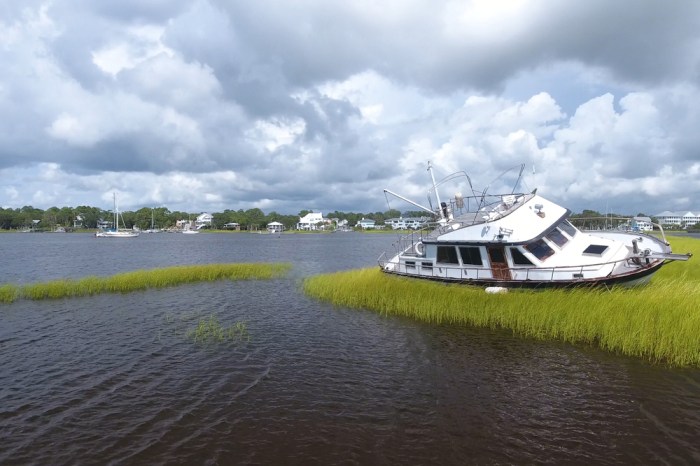If your inboard/outboard boat runs aground – When an inboard/outboard boat runs aground, it can be a stressful and potentially dangerous situation. This guide provides a comprehensive overview of the steps to take to assess the situation, ensure safety, free the boat, inspect for damage, implement prevention measures, and respond to emergencies.
If Your Inboard/Outboard Boat Runs Aground

Running aground is a common hazard for boaters, especially in shallow waters or unfamiliar areas. It can cause damage to the boat and its components, and in some cases, it can even lead to injury or death.
If your boat runs aground, it is important to take immediate action to assess the situation, ensure the safety of passengers and crew, and begin the process of freeing the boat. Here are some steps to follow:
Assess the Situation
The first step is to assess the situation and determine the extent of the damage. Check for any visible damage to the hull, propeller, or other components. Also, check for any leaks or flooding.
If the damage is minor, you may be able to free the boat yourself. However, if the damage is severe, you may need to call for assistance.
Safety Precautions
Before attempting to free the boat, it is important to take some safety precautions.
- Put on a life jacket.
- Secure all loose objects on the boat.
- Move all passengers and crew to the opposite side of the boat from the grounding.
- Be aware of any potential hazards, such as sharp objects or underwater debris.
Freeing the Boat, If your inboard/outboard boat runs aground
There are several techniques that can be used to free a grounded boat.
- Rocking the boat:This involves shifting the weight of the passengers and crew from side to side to create a rocking motion. This can help to dislodge the boat from the sand or mud.
- Pushing the boat:If there are enough people on board, you can try to push the boat off the sand or mud.
- Using flotation devices:If you have any flotation devices, such as life jackets or empty fuel tanks, you can place them under the boat to help it float.
- Calling for assistance:If you are unable to free the boat yourself, you may need to call for assistance from the Coast Guard or a towing service.
Inspecting the Boat
Once the boat has been freed, it is important to inspect it thoroughly for any hidden damage.
Check the hull for any cracks or holes. Also, check the propeller and other components for any damage.
If you find any damage, it is important to have it repaired as soon as possible.
Prevention Measures
The best way to avoid running aground is to be aware of the water depth and navigation charts.
Also, use a depth finder and other navigation aids to help you avoid shallow water.
Finally, be sure to practice proper boat handling and maneuvering techniques.
Emergency Response
In the event of an emergency, it is important to know how to contact the Coast Guard or other emergency services.
Also, be sure to have an emergency plan in place.
This plan should include information on how to contact emergency services, how to signal for help, and how to evacuate the boat.
Answers to Common Questions: If Your Inboard/outboard Boat Runs Aground
What should I do immediately if my boat runs aground?
Assess the situation, check for damage, and determine the severity of the grounding.
How can I prevent my boat from running aground?
Use navigation charts, depth finders, and proper boat handling techniques.
What are the potential hazards of running aground?
Hull damage, propeller damage, and injuries to passengers and crew.

